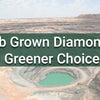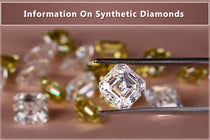Hearing synthetic diamonds always makes people do a double-take (at least internally). One of the reasons why CVD lab grown diamond has an infamous reputation is because the long formation process of natural diamonds is romanticized. However, there is something to counter that, the creation of diamonds is similar to that of natural ones, just free of dirt and much faster. Considering this, a CVD diamond is as precious as a mined one, right? If you are new to the concept of CVD diamonds or wondering, “What does CVD stand for?”, Diamondrensu is here to introduce you to them.

0.90 CT Round Brilliant Cut Loose Lab Grown Diamond
What is CVD Diamond?
Natural diamonds are undoubtedly fabulous. They signify luxury, elegance, and beauty, all packed into one sparkling package. However, obtaining this goodness from nature leads to numerous ecological violations and ethical concerns. The rising awareness about sustainability and environment-friendliness has led people to opt for ethical jewelry choices.
CVD diamonds are one such alternative that has taken over the diamond market. Made through Chemical Vapor Deposition, these synthetic diamonds are made in labs from a hydrocarbon gas mixture. The process is started with a small thin diamond, called the diamond seed, placed in a sealed chamber and heated to around 800°C. This chamber is then filled with methane or other carbon-rich gasses to be ionized into plasma. Next, microwaves and lasers are used to induce ionization and break the molecular bonds present in the gas. As this happens, the pure carbon sticks to the seed diamond and builds into a crystal in layers.
So far, CVD is considered the best process to grow diamonds in a lab. Thus, it is no wonder that CVD diamonds have a significant upper hand in today's diamond market. For instance, there is no way you can resist the allure of this gorgeous stone created using CVD.
Properties of a CVD diamond
The diamonds mined from the earth and those carefully created in a lab are almost similar in all their properties. CVD diamonds come within the range of a natural diamond’s hardness and thermal conductivity. In terms of strength, these two diamonds cannot be distinguished either. Thus, it is safe to say that CVD diamonds and natural diamonds are equally durable and possess similar brilliance to gemstones.
The optical properties of lab grown CVD rough diamonds can be altered with the help of numerous controlled processes. For example, with any colorless or near-colorless crystal, their optical properties can be varied by controlling the residual nitrogen level in the chamber where CVD occurs. The same goes for other colored diamonds. For example, the color blue is added to a crystal with the introduction of boron to the gas. In contrast, pink, yellow, and other colors are a result of high nitrogen concentrations along with mixtures of gasses.
Another property of diamonds created via CVD is that all the crystals in a batch have the same color and clarity. This makes grading and matching them easier and simplifies the process of accurately recreating a color. In this manner, CVD helps maintain a steady supply of high-quality diamonds identical in color, clarity, and size. In addition, the ability to control the size and clarity of the diamond makes these diamonds suitable for other applications as well.
How Do You Identify a CVD Diamond?
Most people look at other alternatives to diamonds, such as moissanite, and think identifying natural diamonds from synthetic diamonds is a simple task. In the simplest terms, there is no way to tell the difference between mined and CVD diamonds with a glance alone. Jewelers and other experts need specialized tools to separate a natural diamond from its cultured counterpart. These gems must be examined under microscopes, and get them tested by reputed labs like GIA, IGI, or any other similar labs.
Most jewelers mention whether the gems they use are sourced naturally or grown in a lab. However, diamond jewelry always comes with a certification that points out the origins of the materials used in its making.
 0.85 CT Round Brilliant Cut Lab Grown Diamond Halo Ring
0.85 CT Round Brilliant Cut Lab Grown Diamond Halo Ring
CVD Diamond Grading and Certification
Like natural diamonds, CVD diamonds are graded based on the 4Cs. The diamond's cut, color, clarity, and carat are tested for each stone, and gemologists authenticate this information in reputed labs. On occasion, diamonds undergo more than one certification process to obtain the correct grade and certificate. All the findings of such tests are curated in a report that comprises all the information regarding the diamond. Verifying this information is perhaps the most important part of purchasing and owning a diamond. There are also fancy color CVD diamonds available.
Initially, many diamond labs graded cultured diamonds differently from natural ones. However, this is not the case anymore. Internationally approved laboratories such as the International Gemological Institute (IGI), Gemological Institute of America (GIA), Antwerp World Diamond Center (AWDC), and Gemological Science International (GSI) use similar standards of grading scales and assessments in providing diamond certificates.
Based on color, the following grades are assigned:
- Colorless diamonds come under the grades D, E, and F ( Rare in CVD )
- Near colorless fall under G-J
- Faint coloring lands the diamond in K, L, or M categories
- Very Light means N-R
- Light means the diamond is assigned something between S-Z
Based on the inclusions found in the stone, the grading is done as Flawless, Internally Flawless, Very, Very Slightly Included, and so on. CVD diamonds rarely have inclusions to speak of.
Some CVD Diamonds We Think You Might Like
Getting to synthetic diamonds can be difficult, so here is a collection of precious stones and jewelry from Diamondrensu that give you a proper introduction.
This elegant princess-cut cluster ring can make moments with your loved one significant. Perfect for proposals and valentine’s day gifts, the sparkling center princess cut diamond is settled in such a way from the east to the west side. Tiny, brilliant cut stones are set around the center diamond, calling everyone’s eyes down to the ring with its sparkle. The compass setting of the ring is symbolic of how you and your partner guide each other in your lives.
Every old soul in the world has a vintage-style engagement ring with its name on it. And this splendid ring has got your partner’s name on it. So propose a ring that will blow your beloved mind away and do it in style. This halo engagement ring includes a center round cut lab grown diamond held by four prongs and a sparkling knife-edge milgrain shank. There is no better way to declare your everlasting love than with this ring.
Need a little treat for yourself? Invest in something that is versatile and will last forever. This pair of synthetic diamond earrings is a perfect companion to dates, work, weddings, and everything in between. Tiny, beautiful, round, brilliant cut diamonds gracefully surround the center stone and add an extra charm to the earrings, giving you a boost of radiance wherever you go. Of course, this is also a charming gift for birthdays and graduations.
Even a little bit of sustainability goes a long way, and what’s a better way to convey this message than with your lab grown bridal sets? This set includes beautiful marquise lab grown diamonds and the band includes an endless row of beautiful baguettes and round lab grown diamonds to please the eyes.
If you hear someone say, “What is CVD diamond good for?” wouldn’t it be great if you had a sample to pull out? If you wish to surprise people that way, this 2-carat marquise-cut diamond is just the right stone for your accessories. This stone can be set in a pendant or an engagement ring that gleams brightly on your partner’s fingers. If you need to introduce someone to the virtues of synthetic diamonds, this is the best stone to start with.
Baguette and Round Lab Grown Diamond Wedding Band
In Conclusion
Everyone deserves diamonds. This is not up for debate. However, the kind of diamond you choose for yourself can be decided after a discussion. Natural vs. cultured diamonds, HPHT vs CVD diamonds, and the 4Cs of a diamond are all choices you need to make before purchasing diamond jewelry.
When it comes to a lab grown diamond CVD is by far the most supported process, and investing in diamonds produced this way is a wise choice. Diamondrensu takes great care to supply you with the best gems and jewelry in the world. In addition, Diamondrensu’s collection of CVD diamonds makes shopping for diamonds an even better experience.
Go ahead and check out this outstanding collection now!












